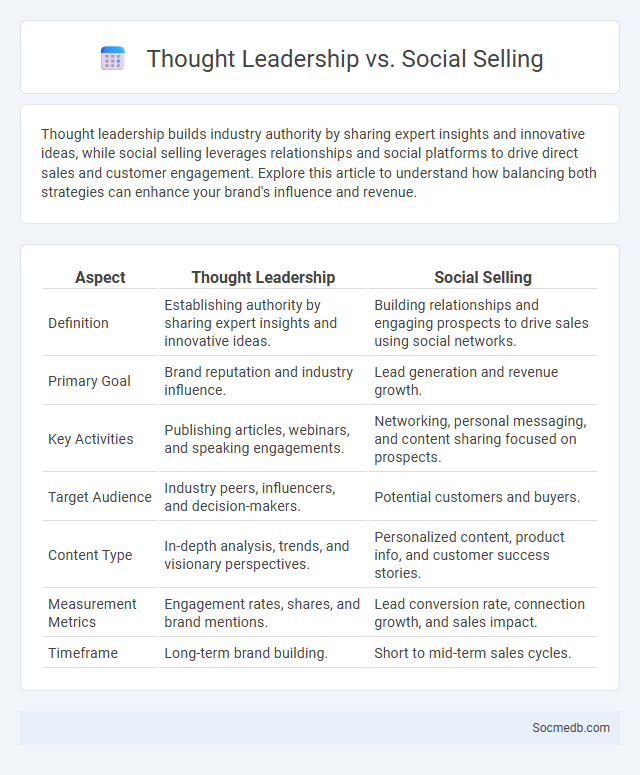
Photo illustration: Thought Leadership vs Social Selling
Thought leadership builds industry authority by sharing expert insights and innovative ideas, while social selling leverages relationships and social platforms to drive direct sales and customer engagement. Explore this article to understand how balancing both strategies can enhance your brand's influence and revenue.
Table of Comparison
| Aspect | Thought Leadership | Social Selling |
|---|---|---|
| Definition | Establishing authority by sharing expert insights and innovative ideas. | Building relationships and engaging prospects to drive sales using social networks. |
| Primary Goal | Brand reputation and industry influence. | Lead generation and revenue growth. |
| Key Activities | Publishing articles, webinars, and speaking engagements. | Networking, personal messaging, and content sharing focused on prospects. |
| Target Audience | Industry peers, influencers, and decision-makers. | Potential customers and buyers. |
| Content Type | In-depth analysis, trends, and visionary perspectives. | Personalized content, product info, and customer success stories. |
| Measurement Metrics | Engagement rates, shares, and brand mentions. | Lead conversion rate, connection growth, and sales impact. |
| Timeframe | Long-term brand building. | Short to mid-term sales cycles. |
Understanding Thought Leadership: Definition and Importance
Thought leadership in social media involves establishing authority and expertise by consistently sharing insightful, valuable content that influences industry trends and shapes audience perspectives. It fosters trust and credibility, driving engagement and expanding a brand's reach across platforms such as LinkedIn, Twitter, and Instagram. Recognizing thought leadership's role enhances strategic content creation, positioning individuals or organizations as go-to sources in their niche.
What is Social Selling? Core Principles and Benefits
Social selling leverages social media platforms like LinkedIn, Instagram, and Twitter to build meaningful relationships with potential customers by sharing relevant content and engaging directly with their needs. Core principles include authentic interaction, personalized communication, and consistent value delivery to foster trust and long-term connections. By embracing social selling, your business can accelerate lead generation, improve brand awareness, and increase conversion rates through genuine social engagement.
Thought Leadership vs Social Selling: Key Differences
Thought leadership on social media establishes authority by sharing expert insights, innovative ideas, and industry trends to build trust and credibility over time. Social selling leverages relationship-building and personalized interactions to directly engage prospects, driving conversions through targeted communication. While thought leadership cultivates brand reputation, social selling focuses on accelerating the sales process through meaningful customer connections.
Overlapping Strategies: When Thought Leadership Meets Social Selling
Integrating thought leadership with social selling enhances brand authority and fosters trust by providing valuable insights while directly engaging with potential customers. Utilizing consistent, high-quality content combined with personalized interactions on platforms like LinkedIn and Twitter drives both audience growth and conversion rates. This overlapping strategy leverages expertise to build relationships that translate into measurable sales opportunities and sustainable business growth.
Establishing Authority: Building Credibility in Your Industry
Establishing authority on social media requires consistently sharing valuable, industry-specific content that showcases your expertise and insights. Engaging with your audience through thoughtful responses and participating in relevant discussions further enhances your credibility and trustworthiness. By strategically positioning yourself as a knowledgeable leader, you can strengthen your brand's reputation and influence within your niche.
Leveraging Social Platforms for Thought Leadership
Leveraging social platforms for thought leadership involves consistently sharing insightful content that resonates with target audiences, establishing authority and expertise within a specific industry. Key strategies include engaging with followers through meaningful comments, participating in relevant groups, and utilizing tools like LinkedIn Pulse or Twitter threads to amplify professional perspectives. Regularly analyzing platform analytics helps refine messaging to maximize influence and credibility across channels.
Measuring Success: Metrics for Thought Leadership and Social Selling
Measuring success in social media for thought leadership and social selling involves tracking metrics such as engagement rate, share of voice, and conversion rate. Key performance indicators include follower growth, content reach, and lead generation through platforms like LinkedIn and Twitter. Using analytics tools to monitor sentiment analysis, click-through rates, and audience demographics enhances strategic decision-making and ROI assessment.
Common Pitfalls in Thought Leadership and Social Selling
Common pitfalls in thought leadership and social selling on social media include overpromotion, which alienates audiences by prioritizing sales over value, and lack of authenticity, causing diminished trust and engagement. Failing to tailor content to specific audience segments results in reduced relevance and lower conversion rates. Neglecting consistent interaction and ignoring analytics data limits growth potential and undermines relationship building essential for effective social selling.
Integrating Thought Leadership and Social Selling for Maximum Impact
Integrating thought leadership with social selling leverages expert content to build credibility and foster trust among target audiences. Sharing insightful, original perspectives on social media platforms like LinkedIn amplifies brand authority while enabling personalized engagement that drives sales conversations. This strategic combination enhances lead generation by attracting qualified prospects who value expertise and relationship-driven interactions.
Future Trends: Evolving Strategies in Thought Leadership and Social Selling
Future trends in social media emphasize integrating advanced AI analytics and immersive technologies like AR and VR to enhance thought leadership and social selling strategies. Brands leverage personalized content and micro-influencers to build authentic connections, driving higher engagement and trust among niche audiences. Your success depends on adapting to these evolving tactics, optimizing real-time data insights to create impactful social experiences that convert followers into loyal customers.
 socmedb.com
socmedb.com